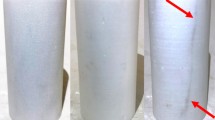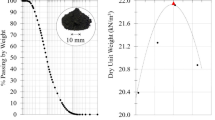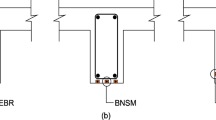Abstract
Bimrocks are a kind of complex geological body composed of a matrix and rock block. There are significant differences in matrix strength within bimrocks induced by geological tectonics, weathering, and so on. In this study, double matrix bimrocks are defined as that there are two matrices in bimrocks. The artificial bimrocks containing 4 kinds of matrix strength differences were fabricated, and the type of artificial bimrocks belongs to strong matrix weak rock block. The strength and failure characteristics of double matrix bimrocks were studied by indoor uniaxial compression tests. The results show that the difference in cohesion between the two matrices under different block proportions has significant effects on the uniaxial compressive strength (UCS) of the double matrix bimrocks. When the block proportion is less than 30%, the UCS of double matrix bimrocks with the small difference of matrix cohesion is lower than that of each single matrix bimrocks. As the difference of matrix cohesion increases, the UCS of double matrix bimrocks is between those of single matrix bimrocks with each matrix strength. When the block proportion is 50%, the UCS of the double matrix bimrocks is close to that of the single matrix bimrocks with stronger matrix. The difference of matrix cohesion has little effect on the UCS of the double matrix bimrocks when the block proportion range is 70 ~ 90%. In terms of failure characteristics, the failure modes of double matrix bimrocks are mainly summarized as penetrating failure, extended failure, and semi-penetrating failure.














Similar content being viewed by others
References
Afifipour M, Moarefvand P (2014a) Mechanical behavior of bimrocks having high rock block proportion. Int J Rock Mech Min Sci 65:40–48. https://doi.org/10.1016/j.ijrmms.2013.11.008
Afifipour M, Moarefvand P (2014b) Failure patterns of geomaterials with block-in-matrix texture: experimental and numerical evaluation. Arab J Geosci 7:2781–2792. https://doi.org/10.1007/s12517-013-0907-4
Alber M, Kahraman S (2009) Predicting the uniaxial compressive strength and elastic modulus of a fault breccia from texture coefficient. Rock Mech Rock Eng 42:117–127. https://doi.org/10.1007/s00603-008-0167-x
American Society for Testing and Materials (2014) Standard test methods for compressive strength and elastic moduli of intact rock core specimens under varying states of stress and temperatures: D7012-14. ASTM International, Philadelphia, USA
Amini M, Ardestani A, Khosravi MH (2017) Stability analysis of slide-toe-toppling failure. Eng Geol 228:82–96. https://doi.org/10.1016/j.enggeo.2017.07.008
Avşar E (2020) Contribution of fractal dimension theory into the uniaxial compressive strength prediction of a volcanic welded bimrock. Bull Eng Geol Environ 79:3605–3619. https://doi.org/10.1007/s10064-020-01778-y
Coli N, Berry P, Boldini D (2011) In situ non-conventional shear tests for the mechanical characterisation of a bimrock. Int J Rock Mech Min Sci 48:95–102. https://doi.org/10.1016/j.ijrmms.2010.09.012
Coli N, Boldini D, Bandini A, Lopes DS (2012) Modeling of complex geological rock mixtures under triaxial testing conditions. p ISRM-EUROCK-2012–108
Hu Y, Sun S, Wei J (2022) Effect of cementation degree on shear characteristic and failure mechanism of bimrocks containing gravels of different sizes. Lithosphere 2022:1334579. https://doi.org/10.2113/2022/1334579
Kahraman S, Alber M (2006) Estimating unconfined compressive strength and elastic modulus of a fault breccia mixture of weak blocks and strong matrix. Int J Rock Mech Min Sci 43:1277–1287. https://doi.org/10.1016/j.ijrmms.2006.03.017
Khorasani E, Amini M, Hossaini MF, Medley E (2019) Statistical analysis of bimslope stability using physical and numerical models. Eng Geol 254:13–24. https://doi.org/10.1016/j.enggeo.2019.03.023
Mahdevari S, Moarefvand P (2016) An investigation into the effects of block size distribution function on the strength of bimrocks based on large-scale laboratory tests. Arab J Geosci 9:1–9
Mahdevari S, Moarefvand P (2018) Experimental investigation of fractal dimension effect on deformation modulus of an artificial bimrock. Bull Eng Geol Environ 77:1729–1737. https://doi.org/10.1007/s10064-017-1074-8
Mahdevari S, Moarefvand P, Mohammadzamani D (2020) Considering the effect of block-to-matrix strength ratio on geomechanical parameters of bimrocks. Geotech Geol Eng 38:4501–4520. https://doi.org/10.1007/s10706-020-01304-7
Medley E (1994) The engineering characterization of melanges and similar block-in- matrix rocks (BIMRock’s). Ph. D. Thesis. University of California
Medley E (2002) Estimating block size distributions of melanges and similar block-in- matrix rocks (bimrocks). In Proc. 5th North American Rock Mechanics Symposium, Toronto, Canada.
Napoli ML, Barbero M, Scavia C (2021) Effects of block shape and inclination on the stability of melange bimrocks. Bull Eng Geol Environ 80:7457–7466. https://doi.org/10.1007/s10064-021-02419-8
Pittalis G, Delisio A, Rossini C, Millesi V (2021) In-situ shear strength testing of conglomerate formation for a large RCC dam (Koysha, Ethiopia). IOP Conf Ser: Earth Environ Sci 833:012055. https://doi.org/10.1088/1755-1315/833/1/012055
Ren M, Zhao G (2021) Prediction of compressive strength of the welded matrix-rock mixture by meso-inclusion theory. Int J Rock Mech Min Sci 139:104612. https://doi.org/10.1016/j.ijrmms.2021.104612
Sharafisafa M, Aliabadian Z, Shen L (2020a) Crack initiation and failure development in bimrocks using digital image correlation under dynamic load. Theor Appl Fract Mech 109:102688. https://doi.org/10.1016/j.tafmec.2020.102688
Sharafisafa M, Aliabadian Z, Shen L (2020b) Crack initiation and failure of block-in-matrix rocks under Brazilian test using digital image correlation. Theor Appl Fract Mech109:102743. https://doi.org/10.1016/j.tafmec.2020.102743
Shi C, Wang D, Wu L, Wu Z (2015) The hydration and microstructure of ultra high-strength concrete with cement–silica fume–slag binder. Cement Concr Compos 61:44–52. https://doi.org/10.1016/j.cemconcomp.2015.04.013
Sonmez H, Gokceoglu C, Medley EW et al (2006) Estimating the uniaxial compressive strength of a volcanic bimrock. Int J Rock Mech Min Sci 43:554–561. https://doi.org/10.1016/j.ijrmms.2005.09.014
Sönmez H, Gokceoglu C, Tuncay E et al (2004) Relationships between volumetric block proportions and overall UCS of a volcanic bimrock. Felsbau 22:
Sonmez H, Kasapoglu KE, Coskun A et al (2009) A conceptual empirical approach for the overall strength of unwelded bimrocks. p ISRM-EUROCK-2009–055
Wang Y, Mao T, Zhang B et al (2022) Macro-meso fatigue damage and instability of a fault bimrock exposed to multistage cyclic triaxial loads with different confining pressure. Fatigue Fract Eng Mater Struct 45:2576–2594. https://doi.org/10.1111/ffe.13770
Zhang S, Tang H, Zhan H et al (2015) Investigation of scale effect of numerical unconfined compression strengths of virtual colluvial–deluvial soil–rock mixture. Int J Rock Mech Min Sci 77:208–219. https://doi.org/10.1016/j.ijrmms.2015.04.012
Acknowledgements
The authors would like to thank the editor and anonymous reviewers for their constructive comments and insightful suggestions.
Funding
The research is funded by China’s postdoctoral science fund (No. 2021M690865) and the open fund of Jiangsu Province Geological Engineering Environment Intelligent Monitoring Engineering Research Center (No. 2021-ZNJKJJ-04) and supported by the fundamental research funds for the central universities (No. B210201002) and natural key projects in Anhui Province (2022AH051751) and Natural Science Foundation of China (No. 42007256 and No. 41672258).
Author information
Authors and Affiliations
Contributions
Kai Li: data curation, formal analysis, validation, writing–original draft. Shaorui Sun: conceptualization, methodology, supervision, funding acquisition. Huilin Le: funding acquisition. Jihong Wei: supervision. Yanran Hu: data curation, formal analysis, funding acquisition.
Corresponding author
Ethics declarations
The authors declare no competing interests.
Rights and permissions
Springer Nature or its licensor (e.g. a society or other partner) holds exclusive rights to this article under a publishing agreement with the author(s) or other rightsholder(s); author self-archiving of the accepted manuscript version of this article is solely governed by the terms of such publishing agreement and applicable law.
About this article
Cite this article
Li, K., Sun, S., Le, H. et al. Study on uniaxial compressive strength of double matrix bimrocks considering different block proportions. Bull Eng Geol Environ 82, 293 (2023). https://doi.org/10.1007/s10064-023-03324-y
Received:
Accepted:
Published:
DOI: https://doi.org/10.1007/s10064-023-03324-y




